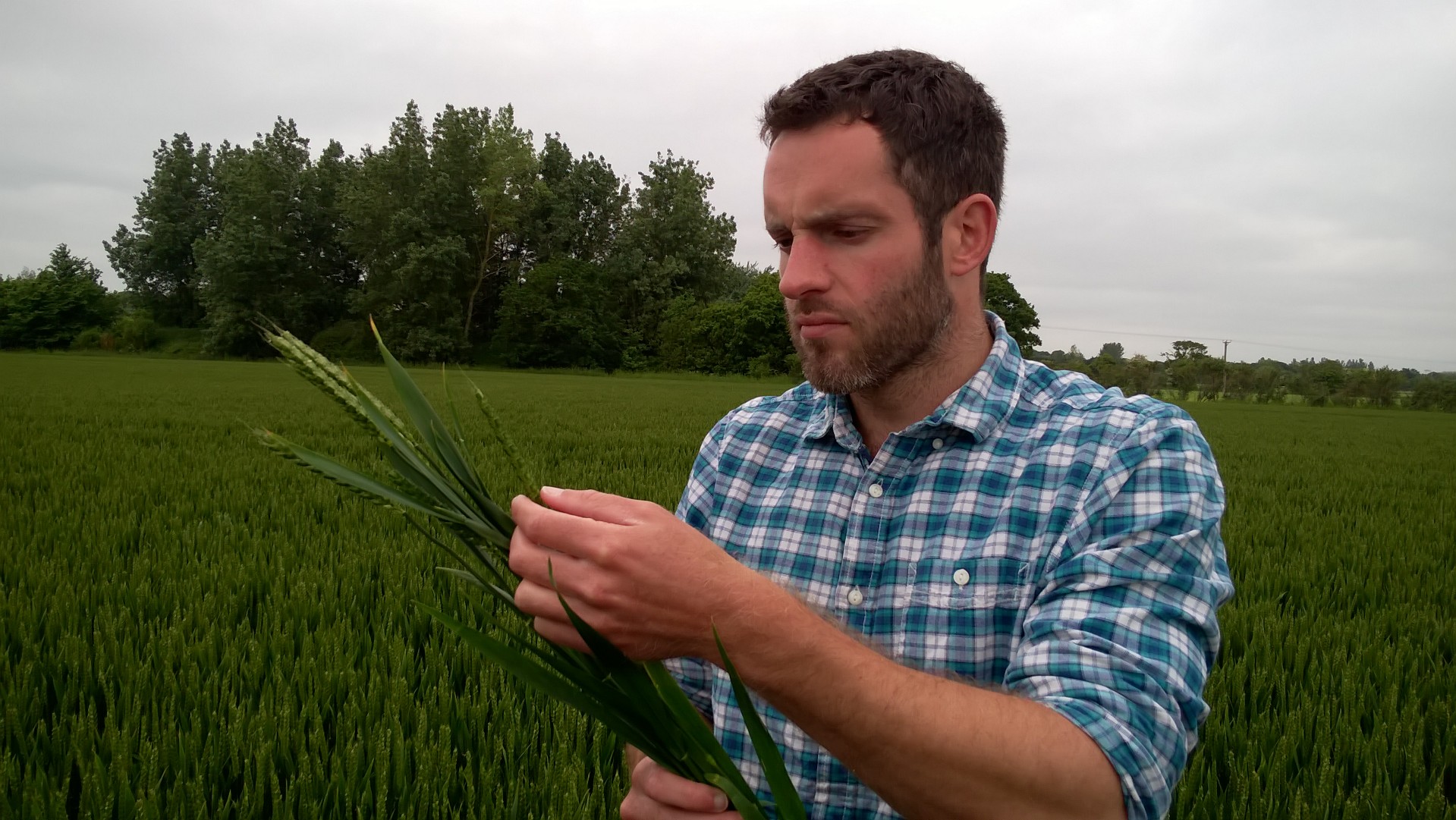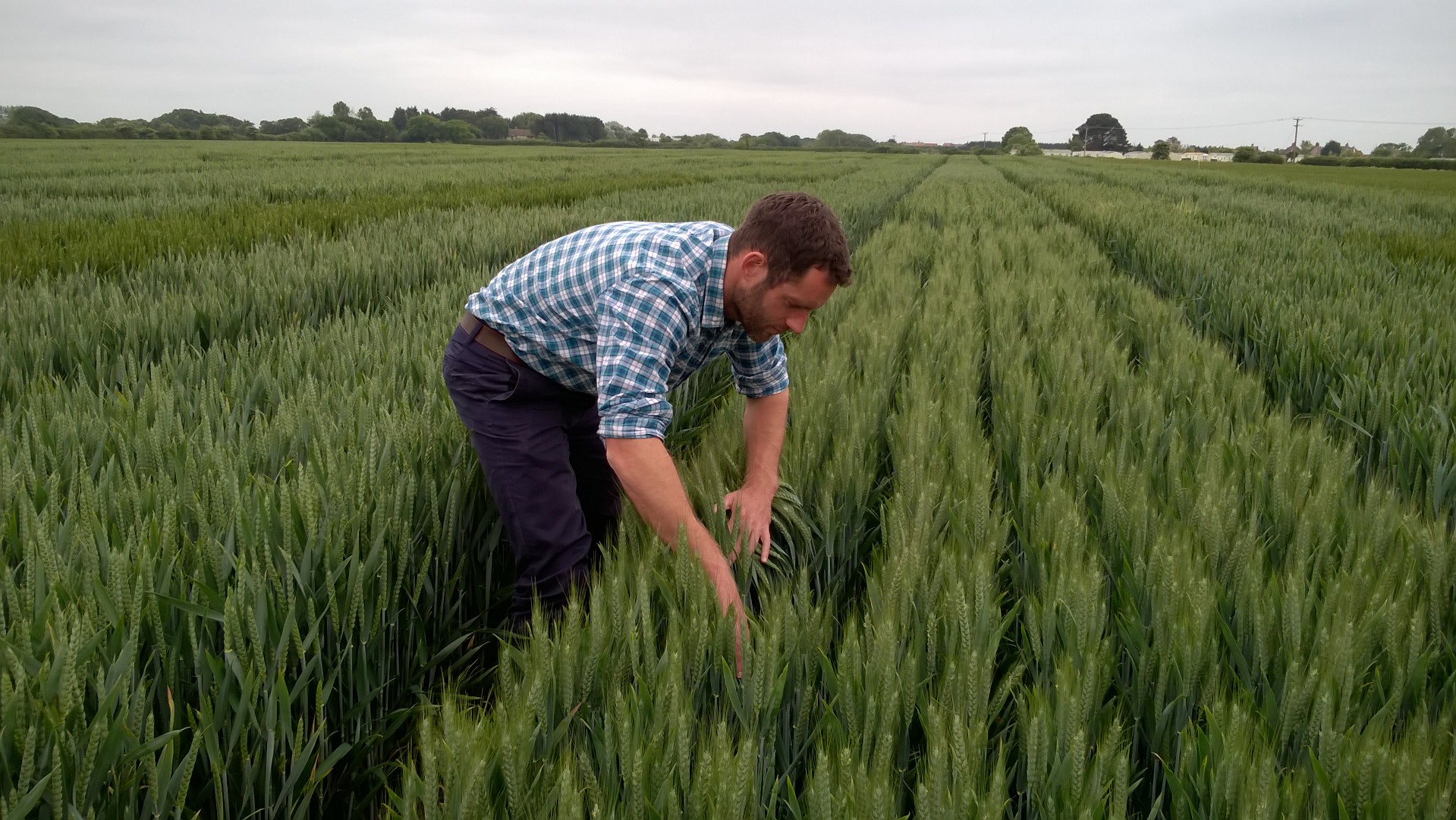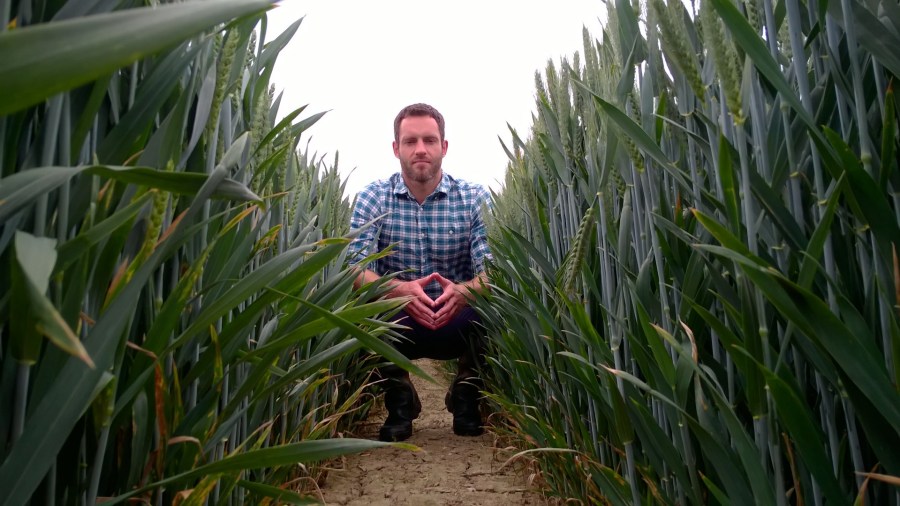On farm trials work forms the basis for how many farming innovations turn into best practice and higher yields. CPM visits an agronomist for whom such research is a passion.
For every idea you give away, you receive just as much, if not more from the feedback.
By Tom Allen-Stevens
You get the impression David Jones is somewhat at home wandering through the wheat trials plots CCC Agronomy runs on behalf of AICC members in West Sussex. Flag leaves are scrutinised for signs of disease, ears pulled apart to inspect the developing grain and the odd plant’s uprooted to investigate how its stem and roots have weathered the season.
“I think it’s odd that Defra stats suggest yields haven’t moved on – for the farmers I work with they have,” he says. “If you know your fields, and how parts of your fields perform, it’s a question of trying something different. If you get a response, it’s worth investigating, and that’s how you turn an 8t/ha crop into one that achieves 11t/ha.”
It’s possibly the enquiring mind that led David Jones into agronomy in the first place. His relatives farm in Devon, and he found from an early age he had an interest in how crops grow. “I was a bit of a nerdy anorak, to be honest, and liked the technical stuff – I wanted to know what would make a plant grow better.”
Few opportunities
But after completing a degree course ten years ago at the Royal Agricultural University, he found a career in agronomy was difficult to get into. “I think things are different now, but at the time there just weren’t the opportunities to get into the industry. I worked for a while on the agricultural side with a bank, but I found it so sales-orientated – giving the best advice while trying to meet sales targets was a real conflict for me and I wanted to pursue my passion for working in agronomy.”
The opportunity to do so arose when he started with CCC Agronomy seven years ago. The company was set up in 1985 by a group of farmers who wanted independent agronomy advice, and it currently has four agronomists covering around 24,000ha in Hants, Sussex and Kent.
“There’s a real emphasis on gathering information and then sitting down with farmers and discussing the findings. It’s allowed me to conduct my own trials over the years, which is where my real interest lies,” says David Jones.

A study of growers’ results found a statistically significant protein benefit of 0.85% on average where Nufol had been applied, says David Jones.
Recently these have included maize. “With the rise in the number of anaerobic digesters, there’s an increase in the area grown, particularly by arable farmers. But I’ve been quite taken aback at how few crop trials are carried out, in comparison with cereals.
“One area in particular was nitrogen stabilisers. The theory is that the Nitrosomonas bacteria slow down the conversion of ammonium into ammonia, reducing leeching losses and making more N available to the plant. Maize is a crop where there could be clear benefits, especially as large amounts of slurry are often applied to it, so I looked around for independent trials.”
What he found was that the work hadn’t been done, so he decided to do it himself. The fully replicated trials compare the use of nitrogen stabilisers both on maize that has received slurry and on crop where liquid-N fertiliser has been applied.
“The difficult part has been assessing results – you can’t really measure yield accurately with a forage harvester, so I’ve had to resort to cutting and weighing areas by hand.
“One thing I did try was to assess the trials with an unmanned aerial vehicle (UAV). Soyl came in to do this, but sadly the data we got from the plots weren’t really conclusive. However, the UAV picked up some really interesting variation over the whole field, and that would be worth exploring in itself,” he notes.
So what did the trials conclude? “There wasn’t a statistically significant result to show the stabiliser had any positive benefit. However, the top two highest-yielding plots did receive the treatment, which shows there’s enough to warrant further investigation.”
It highlights the importance of scientific rigour in any on-farm trials work, he stresses. “Farmers are often presented with trials data, but you have to look at how the conclusions from those trials are drawn – you get a lot of noise and variation, which is why trials should be replicated and you should apply statistical analysis to the results.”
Other farm research he’s been involved with has proven more conclusive, however. “We did some grain protein work with Crop Advisors. It looked at results growers were achieving and related it to late N applications. We found a

Scientific rigour is important in any on-farm trials work – trials should be replicated and you should apply statistical analysis to the results.
statistically significant protein benefit of 0.85% on average where Nufol had been applied. Interestingly, we didn’t get a conclusive benefit from other foliar N applications we looked at,” he reports.
Trials-based research
Then there are the trials CCC Agronomy runs on behalf of AICC members. There are different varieties under scrutiny, as well as disease-response trials to various fungicides and N-response work. These feed into the national programme of trials undertaken by AICC members.
“Ours is an interesting site because it’s very fertile and we have relatively mild conditions. So more than anywhere else, we can push a variety or cropping system and see how it fares.”
The CCC agronomists meet weekly to discuss trials and other crop findings, while regular meetings with farmer clients are not just an opportunity to convey results of on-farm trials but to gather feedback and bounce ideas around.
David Jones feels that sharing the information publicly is also a vital part of progressing knowledge in a particular area – he regularly puts findings out on Twitter and produces a number of technical videos through the season, published on YouTube.
“People involved in trials or crop research often struggle with sharing information that may be regarded as proprietary, or the property only of paying clients. But there’s a community of professional enthusiasts on Twitter you can easily plug into. For every idea you give away, you receive just as much, if not more from the feedback – that stimulates further ideas.”
One he’s come across recently on Twitter is the CombCut – a piece of kit, mainly for organic farmers, that combs weeds out of a crop and may be useful for resistant weeds. “There are so many reasons why it wouldn’t work, it’s got to be worth a try in small replicated plots to assess its value on blackgrass,” he says.
Another product, again mainly targeted at organic farmers, that he’s keen to put through on-farm trials is an inoculant for peas that stimulates a plant’s defence mechanism to disease. “It makes a plant think it’s being attacked, so gears up its readiness for disease. In theory, it should complement a fungicide programme, and could be invaluable on downy mildew, so well worth on-farm trials.”
On maize, he feels there’s plenty of scope for further investigation with precision farming techniques. “The N Max restriction of 150kgN/ha is a real limiting factor for the crop, but there’s such variation in growth. You could use NDVI images to tailor liquid N or even slurry applications better to meet crop requirements. The work simply hasn’t been done, but it’s crying out for good on-farm trials, and it would be fascinating to find out,” says David Jones.
How to be an on-farm innovator – David Jones’ top tips
- Allocate the time, space and thought. Think about what you want to research, then assign an area of a field to your project and give it the time it deserves to ensure you get proper results – most commercial businesses have an R&D budget so it’s an area worth resourcing.
- Don’t be afraid to fail. A negative response in on-farm trials work is still a positive result, and an indication of how to progress the work.
- Get the team on board. If your trials rely on the work of farm staff or contractors, make sure they feel part of the process and understand the importance of maintaining a high scientific standard. If on your own, look out for like-minded individuals who can share the workload and bring valuable skills, such as a UAV operator.
- Keep an open mind. A lot of trials work can be chicken and egg and results won’t always go in the direction you expect – be prepared to revisit your hypothesis. Also, make sure the trials are scientifically rigorous and that you apply statistical analysis to results.
- Explore what others are doing. Visit other on-farm trials and make the most of events, such as Cereals to gather information. But have specific aims for what you want to achieve from these visits so you make best use of your time.
- Make the most of the results. Try to get the information out in a way that stimulates feedback and discussion – that’s the best way for it to be practically applied and will prompt new ideas for further investigation.
A passion to learn and the drive to share ideas

The real on-farm innovators are the ones who look outside conventional agriculture for their ideas, reckons Andrew Clune.
As the BASF agronomy manager for the South, Andrew Clune knows David Jones well, and they often meet at local
trials or farm open days. “But what sets David apart from many other agronomists is his use of social media,” he notes.
“Only a handful of agronomists are putting themselves out there and using Twitter and YouTube to share information and query what they find. David is very effective at using social media to crowd-source ideas and feed off the responses he gets.”
Hand-in-hand with this is his passion for doing his own trials work. “He has an idea, takes the initiative and drives it through. There are many in the industry who are happy just to contribute to their own company trials – David takes it one step further, and he’s keen to share the findings and learn from the feedback.”
Andrew Clune believes David Jones is one of a growing number of agronomists who have a different mindset. “It’s about embracing change, and it resonates well with younger farmers and farm managers. This is combined with a good understanding of the local audience and priorities – taking national developments and knowing how to test and apply them locally.”
The value of on-farm trials shouldn’t be underestimated, he points out. “Most businesses put money into new ideas – indeed BASF invests 10% of its turnover in R&D. But how many farmers rely on others to do the research? For a 200ha farm, putting just 2ha into some trials to investigate doing a few things differently will give you a real insight into what might help solve an issue or eke out a little extra yield.”
He’s also a keen advocate of local open days and events. “There are many really valuable on-farm events that take place in the South, run by NIAB, AHDB or local companies. In places, we have our own microclimate and septoria can be a huge issue for some growers to deal with, for example. I’m convinced those who come with an open mind to on-farm events benefit from sharing information and ideas.
“But the real on-farm innovators are the ones who look outside conventional agriculture or even outside farming for their ideas and think about how those might be applied to their farm.”
With a business that spans a range of industries, including transport, construction, plastics and pharmaceuticals, BASF is continually looking across its wide product base for new ideas to bring into agriculture, he notes. “It’s an exciting time, with some fascinating technology coming through. We’re always looking for progressive farmers and agronomists to work with, to bring these ideas on to farm and to see what lessons can be learned locally.”
On-farm innovation
Farmers are constantly innovating to improve their businesses, which is why BASF is committed to investing 10% of its sales revenues into R&D to deliver new technologies for farming. BASF’s new innovations include pioneering agricultural chemistry, as well as Innovations Beyond Crop Protection like biologicals, bacteria, soil and water  management and renewable technologies. Our future is firmly focused on delivering towards farming’s future.’
management and renewable technologies. Our future is firmly focused on delivering towards farming’s future.’




